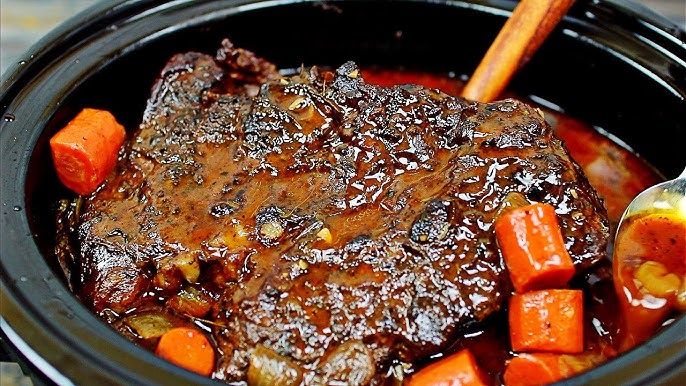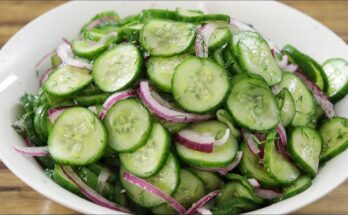Beef Roast Crock Pot Recipe: Cooking a beef roast in a crock pot is one of those timeless kitchen traditions that brings comfort, warmth, and mouthwatering aromas into your home.
The beauty of using a slow cooker lies in its simplicity—you can prepare everything in the morning, set it, and by dinnertime, you’ll have a tender, flavorful roast that tastes like it’s been made by a professional chef.
In this guide, I’ll take you through everything you need to know, from the ingredients you’ll need to the step-by-step cooking process, along with helpful tips to make your beef roast a guaranteed success.
Why the Crock Pot is Perfect for Beef Roast
The crock pot is ideal for beef roast because it takes a cut of meat that may normally be tough and transforms it into tender, fall-apart deliciousness. Cuts like chuck roast or rump roast, which are often less expensive, benefit from long, slow cooking because the connective tissues break down into rich, flavorful juices. Instead of worrying about dry or chewy beef, the crock pot ensures your roast stays juicy and full of flavor.
Benefits of Slow Cooking
There are several advantages to slow cooking your beef roast:
- Time-Saving – You can prep in just 20 minutes, set your crock pot, and leave it to cook while you focus on your day.
- Flavor Development – The long cooking process allows spices, herbs, and broth to soak into every bite.
- One-Pot Meal – Add veggies like carrots, potatoes, and onions, and you’ll have a complete dish ready without using multiple pans.
- Budget-Friendly – Since tougher cuts of beef are perfect for slow cooking, you save money without sacrificing taste.
Ingredients You’ll Need
Before you begin, gathering the right ingredients will make your beef roast truly unforgettable.
Essential Ingredients for Beef Roast
Here’s what you absolutely need:
- 3–4 lb beef chuck roast (or rump roast)
- 1 large onion, sliced
- 3–4 carrots, peeled and chopped
- 4–5 medium potatoes, cubed
- 3–4 cloves garlic, minced
- 2 cups beef broth (or stock)
- 2 tbsp olive oil (for searing, optional)
- Salt and black pepper to taste
Optional Ingredients for Extra Flavor
Want to elevate your roast? Add these:
- 1–2 sprigs fresh rosemary or thyme
- 1 cup red wine (adds richness to the broth)
- 1 tbsp Worcestershire sauce
- 1 bay leaf
- 1 tbsp tomato paste (for depth of flavor)
- Celery stalks (for added aroma)
Choosing the Right Cut of Beef
The cut of beef you choose makes all the difference. The best cuts for crock pot roasts include:
- Chuck Roast – Most popular, marbled with fat, very tender when slow-cooked.
- Rump Roast – Leaner but still flavorful when cooked with enough broth.
- Brisket – Slightly tougher, but becomes melt-in-your-mouth soft in a crock pot.
Tip: Avoid expensive cuts like ribeye or tenderloin for crock pot cooking—they don’t need the long, slow process and it’s better to save them for grilling or roasting.
Step-by-Step Guide to Cooking Beef Roast in a Crock Pot
This is where the magic happens. Follow these steps carefully, and you’ll end up with a crock pot beef roast that tastes like it came straight from a farmhouse kitchen.
Step 1 – Preparing Your Beef Roast
Start by trimming any excess fat from your beef roast. While some fat adds flavor, too much can make your dish greasy. Pat the meat dry with a paper towel—this helps it brown better if you choose to sear it.
Searing the roast in a skillet with olive oil for about 3–4 minutes per side creates a golden crust that locks in juices and adds a richer flavor. While this step is optional, I highly recommend it for the best results.
Step 2 – Seasoning and Marinating the Meat
Generously season your beef with salt, black pepper, and garlic. You can also add paprika, onion powder, or Italian seasoning for more complexity. If you have time, marinate your beef overnight in olive oil, garlic, herbs, and a splash of Worcestershire sauce. This helps the flavors penetrate deeper into the meat.
Step 3 – Adding Vegetables and Broth
Place the onions, carrots, and potatoes at the bottom of your crock pot. These act as a flavorful base and soak up the juices. Set your seared (or raw) beef roast on top. Pour in beef broth, and if you’re using wine, add that as well. Toss in herbs like rosemary, thyme, and bay leaf. This combination creates a hearty, flavorful cooking liquid that doubles as gravy later.
Step 4 – Setting the Crock Pot (Cooking Time & Temperature)
- For a 3–4 lb roast, cook on LOW for 8–10 hours or HIGH for 4–6 hours.
- Cooking on low heat is always preferred since it allows the beef to break down slowly, resulting in more tenderness.
- Resist the urge to open the lid too often—each time you do, you release heat and add up to 30 minutes of extra cooking time.
Step 5 – Serving the Perfect Crock Pot Beef Roast
Once the roast is fork-tender, remove it from the crock pot and let it rest for about 10 minutes before slicing. Use the leftover juices as they are, or thicken them with a cornstarch slurry to make delicious homemade gravy. Serve with the cooked vegetables for a wholesome, hearty meal.
Tips and Tricks for the Best Crock Pot Beef Roast
While the recipe itself is straightforward, a few insider tips can take your roast from good to unforgettable.
How to Avoid Overcooking
Believe it or not, you can overcook meat in a crock pot. While slow cooking usually makes it tender, leaving it for too long may cause the meat to become stringy and dry. Stick to recommended cooking times and always check for doneness.
How to Make the Gravy from Juices
After removing the beef and vegetables, strain the cooking liquid into a saucepan. Bring it to a simmer and add 1–2 tbsp cornstarch mixed with cold water. Stir until thickened, and you’ll have a rich, silky gravy to pour over your roast.
Common Mistakes to Avoid
- Not Searing the Beef – While optional, searing adds depth of flavor.
- Too Much Liquid – Remember, the crock pot retains moisture, so you don’t need as much broth as stovetop recipes.
- Using Lean Cuts – Lean cuts dry out; always go for marbled cuts.
Variations of Crock Pot Beef Roast
One of the best parts about cooking beef roast in a crock pot is its versatility. The base recipe is classic and comforting, but you can easily switch it up with new flavors to suit your mood or occasion. Let’s dive into some delicious variations that will keep your family excited every time you serve this dish.
Classic Beef Roast with Potatoes and Carrots
The timeless version includes potatoes and carrots, simmered alongside the roast in a savory broth. This is the kind of meal that brings back childhood memories of Sunday dinners. The potatoes absorb the beefy juices, turning them into tender, flavorful bites, while the carrots add natural sweetness that balances the richness of the meat.
For a little twist, you can swap white potatoes with baby red potatoes or even sweet potatoes for a healthier option. If you love a bit of extra flavor, toss in pearl onions instead of regular onion slices. This small change adds a subtle sweetness that complements the savory broth.
Garlic and Herb Beef Roast
If you’re a fan of aromatic dishes, this version is for you. Instead of sticking to the traditional salt-and-pepper seasoning, rub your beef with minced garlic, rosemary, thyme, and a little olive oil before searing. Then, add fresh herbs directly into the crock pot along with your broth.
The slow cooking process infuses every bite with earthy, herby goodness. Pair it with roasted vegetables or mashed potatoes, and you’ll have a dish that feels gourmet but requires minimal effort.
Spicy BBQ Beef Roast
Want something bold and different? A BBQ beef roast is a mouthwatering twist. Instead of broth, use a combination of beef stock and your favorite barbecue sauce. Add sliced jalapeños or a dash of chili flakes for extra heat.
The result is a tender, slightly smoky roast with just the right amount of spice. You can shred the beef after cooking and serve it on buns as BBQ beef sandwiches or over rice for a hearty meal. It’s perfect for casual gatherings and game-day feasts.
Storage and Reheating Tips
A crock pot beef roast often makes more than one meal, which is fantastic because it stores well and reheats beautifully. To enjoy leftovers without losing flavor or texture, follow these storage and reheating tips.
How to Store Leftovers
- Cooling Down – Let the roast cool slightly before storing. Don’t leave it at room temperature for more than two hours.
- Portioning – Cut the roast into slices or chunks and store them with the vegetables in airtight containers.
- Storing with Juices – Always keep some of the cooking liquid with the meat. It helps preserve moisture and flavor.
- Refrigeration – Store in the fridge for up to 4 days.
- Freezing – For longer storage, freeze portions with broth in freezer-safe bags or containers for up to 3 months.
Best Ways to Reheat Without Losing Flavor
The secret to reheating beef roast is to do it slowly to prevent drying out.
- Stovetop Method: Place the meat and veggies in a skillet with some cooking liquid. Cover and warm on low heat until hot.
- Oven Method: Preheat to 300°F, cover the roast with foil, and bake until warmed through (about 20–30 minutes).
- Microwave Method: Use only if you’re in a rush. Add a splash of broth, cover loosely, and heat in short intervals, stirring in between.
Pro Tip: If you froze your beef roast, thaw it in the refrigerator overnight before reheating for best results.
Nutritional Value of Crock Pot Beef Roast
A homemade crock pot beef roast isn’t just delicious—it’s also packed with nutrition, especially if you include vegetables like carrots, potatoes, and onions.
Calories and Macronutrients
On average, a 3–4 oz serving of beef roast with vegetables contains:
- Calories: 350–400
- Protein: 30–35g
- Fat: 15–20g (depends on the cut)
- Carbohydrates: 20–25g (from potatoes/carrots)
- Fiber: 3–4g
This makes it a well-rounded meal, with protein for muscle building, complex carbs for energy, and healthy fats for satiety.
Health Benefits of Beef and Vegetables
- Beef: A great source of iron, zinc, and vitamin B12, which are essential for energy and red blood cell production.
- Carrots: Rich in beta-carotene, which supports vision and immunity.
- Potatoes: Provide potassium for heart health and complex carbs for steady energy.
- Onions and Garlic: Contain antioxidants that support overall wellness and boost immune function.
By slow cooking these ingredients together, you’re not just making a meal—you’re creating a nutrient-packed dish that nourishes your body and satisfies your taste buds.
FAQs about Beef Roast Crock Pot Recipe
1. Can I use frozen beef roast in the crock pot?
Yes, but it’s not recommended. Starting with frozen meat can increase cooking time and may affect food safety. Always thaw your roast in the refrigerator first for best results.
2. What is the best liquid to cook beef roast in?
Beef broth is the classic choice, but you can also use chicken broth, vegetable broth, red wine, or even beer to enhance the flavor.
3. How do I make my beef roast more tender?
Choose the right cut (like chuck roast), cook it on low for several hours, and don’t skip the broth—it helps keep the meat juicy.
4. Can I add wine or beer for flavor?
Absolutely! Red wine adds depth and richness, while beer gives a slightly malty, savory flavor. Just replace part of the broth with your preferred drink.
5. What side dishes go best with beef roast?
Mashed potatoes, roasted vegetables, rice, or a simple green salad all pair wonderfully with crock pot beef roast.
Conclusion
Pair your roast with crusty bread, a side salad, or even a glass of red wine, and you’ll have a dinner that rivals any restaurant. The best part? Leftovers reheat beautifully, so you can enjoy the comfort all over again without extra work.
If you haven’t already, it’s time to dust off your crock pot and give this beef roast recipe a try—you’ll be amazed at how simple, delicious, and satisfying it truly is.



